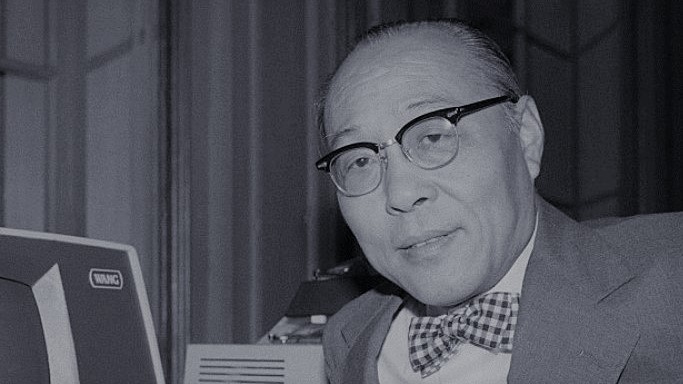Preamble
The Australian Computer Society (ACS) was formed 50 years ago, when the various state computer societies joined forces.
To mark the occasion, the ACS has produced a heritage project to honour the many individuals who have contributed to the growth of the ICT profession in Australia.
At the heart of the project is a history of computing in Australia. It is not just a history of the ACS, but the history of a profession.
Australia has the longest computing history of any country, excepting the US and the UK, and CSIRAC in the Museum of Victoria is the oldest computer still in existence.
Chapter 39: Wang in Australia
An important player in the minicomputer boom in Australia in the 1980s was Wang Laboratories. Like DEC (Chapter 35) and Prime (Chapter 38), it was based in Massachusetts.
The company had its origins in 1951, when Chinese immigrant and Harvard graduate An Wang started a company to develop technology he had been working on at the university in what was to become known as core memory.
Wang sold a patent for the technology to IBM for $500,000 in 1955, enabling him to build a larger business. Problems with the deal gave him a lifelong animosity towards IBM.
The company moved into calculators and then word processers, where it became a market leader. It moved into minicomputers in the 1970s. The Wang VS system, introduced in 1977, had a very similar instruction set to the IBM’s early mainframe, the System/360. This was to be instrumental in the success of Wang in Australia.
The local subsidiary was established in 1973 under Marvin Cook. He was replaced by Tom Lambert, and then in 1978 by Richard Connaughton. All were Americans.
Connaughton’s brief was to hire a local to replace him. He didn’t find an Aussie, but he got the next best thing. In 1979 Mike Clarkin became managing director, after successfully establishing Wang in his native New Zealand
Clarkin ran Wang during its most successful years in Australia, and was instrumental in landing Wang’s biggest ever global order, the $63 million Stratplan deal (that amount was Wang’s component only) with the Department of Social Security in 1983.
Stratplan was enormous. Coordinated by Computer Power (see Chapter 31), it involved Amdahl mainframes in Canberra and every state capital, and nearly 300 Wang VS minicomputers, at least one in every DSS office in Australia. The Wang machines were connected to the mainframes by 9.6 Kbps data lines supplied by Telecom.
They communicated using IBM’s SNA (Systems Network Architecture) protocol. It was the largest SNA network in the world – and the only IBM product involved was the mainframe operating system.
As part of the deal Wang set up a manufacturing facility in Canberra to make thousands of colour terminals to sit in the DSS offices. Stratplan meant that Wang had to substantially ramp up its operations in Australia, in every department.
That deal alone ensured that Wang became a major vendor on the local scene. It was successful in many other areas, and within five years was in the top ten computer supplier in Australia.
Like Prime, Wang was much more successful in Australia than it was globally. In the year Stratplan was implemented, more than a quarter of Wang’s worldwide revenues were from Australia, a remarkable figure when Australia comprised only around 3 percent of the global computer market.
Under Mike Clarkin, Wang became one of the largest corporate donors in Australia, sponsoring such organisations as the Sydney Dance Company, the Queensland Ballet, the Sydney Marathon, and the Australian men’s basketball team, the Boomers.
But it was not to last. Like the other minicomputer suppliers of the time, Wang was unable to compete against more powerful PCs at the low-end and the new breed of Unix superminis at the high-end. An Wang died in 1990, not living to see his company’s demise.
In 1991 Wang exited the hardware market to concentrate on imaging software and office productivity. It signed a deal with IBM under which IBM would invest $100 million in the company and Wang would resell IBM AS/400 and RS/6000 machines and convert its existing user base to them. An Wang must have turned in his grave.
Mike Clarkin did not agree with the new direction and left Wang. By this time, he was a leading figure in the Australian computer industry, and after his departure he sat on the boards of many local technology companies.
He made the right decision to leave – Wang entered Chapter 11 bankruptcy in 1992. It emerged a year later and reinvented itself as a services company, with some success, but the boom years were well behind it.
The Wang name disappeared when the company was acquired by Dutch services company Getronics in 1999. Clarkin died in 2008.
Veteran ICT journalist Graeme Philipson has written ‘A Vision Splendid: The History of Computing in Australia’.
It will be available as a PDF download from acs.org.au and ebook from Amazon on 2 November 2017.
Expressions of interest for a hard copy of the book are being accepted at [email protected].
Previously published:
Chapter 38: Prime and the Lionel Singer story
Chapter 37: HP and IBM rule the 80s
Chapter 36: Data General and Sigma Data
Chapter 35: DEC leads the minicomputer boom
Chapter 34: David Hartley, Bill Gates and the one that got away
Chapter 33: Australia’s software entrepreneurs
Chapter 32: Multinational software companies move in
Chapter 31: Birth of Australian software and services industry
Chapter 30: The rise and decline of the PCMs
Chapter 29: ‘Plug compatible manufacturers’ take on IBM
Chapter 28: The rise of Fujitsu
Chapter 26: The rest of the BUNCH
Chapter 25: Honeywell in Australia
Chapter 23: ACS at home and abroad
Chapter 22: The early years of the Australian Computer Society
Chapter 21: Other Australian universities
Chapter 20: University of Melbourne and Monash
Chapter 19: Sydney University and UNSW lead the way
Chapter 18: Computing in the Australian Government
Chapter 17: Trevor Pearcey and the birth of CSIRONET
Chapter 16: Enter the minicomputer – DEC comes to Australia
Chapter 15: The IBM S/360 in Australia
Chapter 14: IBM redefines the computer industry
Chapter 13: Control Data Australia (part II)
Chapter 12: Control Data Australia (part I)
Chapter 11: The Australian Computer Society
Chapter 10: Five Computer Societies
Chapter 9: Australian made, Australian designed
Chapter 8: Australia's Computer Industry in 1962
Chapter 5: SILLIAC and the Snowy Mountains Scheme
Chapter 3: Harry Messel and the birth of SILLIAC










